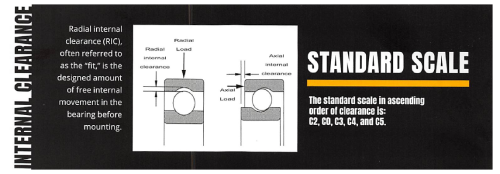Bearing internal clearance refers to the amount of space between the inner and outer rings when one is fixed. This small but crucial gap allows for smooth movement between the bearing components, ensuring proper function under load. The right clearance can enhance performance, while improper clearance may lead to increased wear, noise, or even failure over time. Understanding what bearing internal clearance is, why it's important, and how to choose the right level for your application can make a big difference in the efficiency and longevity of your bearings. The internal clearance directly affects how the rolling elements (like balls or rollers) interact with the raceways inside the bearing. If the clearance is too tight, it can cause excessive friction and heat, reducing efficiency. If it’s too loose, it may result in poor load distribution and increased vibration. Proper clearance ensures that the bearing operates smoothly, efficiently, and reliably. There are two main types of internal clearance: Calculating radial clearance involves subtracting the average diameter of the inner raceway from the outer raceway and adjusting for the ball size. Axial clearance, on the other hand, is usually much larger and plays a key role in high-speed or high-temperature applications. The ideal clearance depends on several factors such as operating conditions, temperature, and load. In general, the lower the clearance, the better for most standard applications. However, in situations where thermal expansion or specific load requirements are present, a slightly higher clearance might be necessary. Factors that influence the choice of clearance include: Selecting the correct clearance helps ensure optimal performance, reduces wear, and extends the life of the bearing. When selecting a bearing, you may come across terms like C0 and C3, which refer to different levels of internal clearance: Choosing between C0 and C3 depends on your specific needs. C3 is ideal for applications where extra space is required to prevent binding due to heat or heavy loads. Emerson Bearing has been a trusted name in the bearing industry for decades, delivering precision-engineered solutions for a wide range of applications. From ball bearings to super-precision bearings, we offer high-quality products designed to meet the toughest demands. Whether you need ceramic bearings, linear motion systems, or custom-engineered solutions, our team is here to help. With a strong commitment to quality and customer satisfaction, we ensure that every bearing meets the highest standards of performance and reliability. Visit our Contact Us page or fill out our Request a Quote form today. Let us help you find the perfect bearing solution for your project. Radiator For Kia,Car Radiators For Kia,Kia Radiator,For Kia Water Cooling Radiator Guangzhou Casselin Trading Co., Ltd. , https://www.casselinautoparts.comWhy Is Internal Clearance Important?

What’s the Ideal Clearance for Your Bearing?
Related Reading:
C0 vs. C3: What’s the Difference?
Why Choose Emerson Bearing?
Bearing Internal Clearance
Radiator For Kia,Car Radiators For Kia,Kia Radiator,For Kia Water Cooling Radiator Guangzhou Casselin Trading Co., Ltd. , https://www.casselinautoparts.com